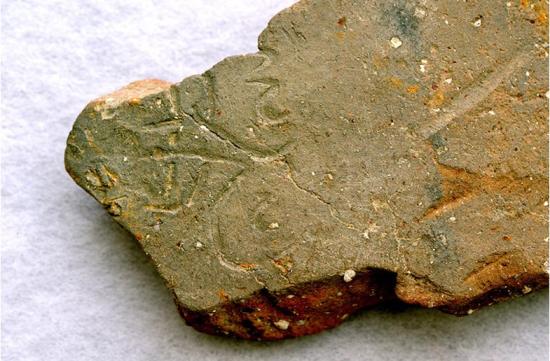Kazuto Tsukamoto
Source http://ajw.asahi.com/article/behind_news/social_affairs/AJ201507300008
 A clay tile bearing a character meaning "flight"in Kashihara, Nara Prefecture (Yoshinori Toyomane)
A clay tile bearing a character meaning "flight"in Kashihara, Nara Prefecture (Yoshinori Toyomane)
Kanji written on clay tiles discovered in Nara Prefecture, some of the oldest writing ever found in Japan, is currently on display to the public.
The tiles, including one with the character for "flight," were unearthed at the site of Asukadera, thought to be Japan's first genuine Buddhist temple. The complex is a national historic site located in the village of Asuka, Nara Prefecture.
The best of the discovered tiles are on display at the Exhibition Room of the Fujiwara Imperial Site in the city of Kashihara, part of the Nara National Research Institute for Cultural Properties, until Sept. 13.
The tiles are thought to date to the temple's founding sometime between the end of the sixth century to the early seventh century. The characters written on them are some of the oldest of their kind seen in Japan.
The kanji for "flight" is also the first character representing the name "Asuka," and the tile bearing this kanji could be the oldest written material to refer to the temple.
The temple was built by Soga no Umako (?-626), a wealthy noble during the Asuka Period and an ardent supporter of Buddhism. Monks and craftsmen skilled in making tiles and other items were dispatched from the kingdom of Baekje on the Korean Peninsula to Japan to construct the first clay-tiled building on these shores, according to "Nihon Shoki" (The Chronicles of Japan).
Since 1956, numerous tiles have been extracted from the area around the site of the temple complex. The tiles now on exhibit were examined again in January of this year. Eleven flat tiles were confirmed with written characters apparently etched with a hard tool before the clay had dried. One of them, a tile found in 1992 that is 10 centimeters high by 11 cm wide, bears the character for "flight."
Haruyuki Tono, a professor of ancient Japanese history at Nara University, points out that "the second kanji meaning 'bird' in the word 'Asuka' has not been confirmed, but the tile could be the oldest written record that refers to Asuka with a combination of the 'flight' kanji and this second one."
Apparently there are also cases of wooden tablets written with just the "flight" character to signify Asukadera temple.
Other written characters verified in addition to "flight" include two characters that read "megawara," meaning "flat tile"; three characters that read "shirakabe," thought to be the name of an artisan's group or clan involved in producing goods; three characters that could be the rank of a monk; and six characters--four identical characters meaning "many" and two identical characters meaning "name"--apparently etched by someone practicing their writing.
The discovery of the kanji was announced by the Nara National Research Institute for Cultural Properties on June 10.